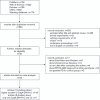Association of CagA EPIYA-D or EPIYA-C phosphorylation sites with peptic ulcer and gastric cancer risks: A meta-analysis
- PMID: 28445260
- PMCID: PMC5413225
- DOI: 10.1097/MD.0000000000006620
Association of CagA EPIYA-D or EPIYA-C phosphorylation sites with peptic ulcer and gastric cancer risks: A meta-analysis
Abstract
Background: Increasingly, studies have focused on the relationship between Helicobacter pylori (H pylori) cytotoxin associated gene A protein (CagA) Glu-Pro-Ile-Tyr-Ala (EPIYA)-D motifs or multiple EPIYA-C phosphorylation sites and peptic ulcer disease (PUD) or gastric cancer (GC) risk. However, the conclusions have been inconsistent. The aim of this meta-analysis was to evaluate whether 1 CagA EPIYA-D motif or multiple EPIYA-C phosphorylation sites were associated with PUD or GC risk.
Materials and methods: A literature search was performed in PubMed, Web of Science, Wanfang Data, Excerpt Medica Database, and the Chinese National Knowledge Infrastructure database to identify eligible research. We analyzed the odds ratios (OR) and 95% confidence intervals (CI) to assess the strength of association.
Results: Compared with 1 EPIYA-C motif in Asian populations, 1 EPIYA-D site was associated with an increased GC risk (OR=1.91, 95% CI=1.19-3.07, P = .008). However, 1 EPIYA-D motif was not significantly associated with PUD (OR = 0.90, 95% CI = 0.46-1.76, P = .764), gastric ulcer (GU) (OR = 0.85, 95% CI = 0.27-2.63, P = .771), or duodenal ulcer (DU) (OR = 0.89, 95% CI = 0.25-3.16, P = .859) risk. Compared with no more than 1 EPIYA-C motif, multiple motifs were associated with increased PUD (OR = 2.33, 95% CI = 1.29-4.20, P = .005) and DU (OR = 2.32, 95% CI = 1.08-5.00, P = .031) risk in Asia and GC risk in the United States and Europe (OR = 3.28, 95% CI = 2.32-4.64, P < .001). Multiple EPIYA-C sites were not associated with GU risk (OR = 4.54, 95% CI = 0.95-21.83, P = .059). There was no publication bias identified in these comparisons.
Conclusions: In Asia, 1 EPIYA-D motif was significantly associated with increased GC risk. Multiple EPIYA-C motifs were associated with increased PUD and DU risk, particularly in Asia. In the United States and Europe, multiple EPIYA-C motifs were associated with increased GC risk. Therefore, detection of polymorphic CagA EPIYA motifs may improve clinical prediction of disease risk.
Conflict of interest statement
Competing Interests: The authors have declared that no competing interests exist.
The authors have no conflicts of interest to disclose.
Figures





Similar articles
-
The EPIYA-ABCC motif pattern in CagA of Helicobacter pylori is associated with peptic ulcer and gastric cancer in Mexican population.BMC Gastroenterol. 2014 Dec 24;14:223. doi: 10.1186/s12876-014-0223-9. BMC Gastroenterol. 2014. PMID: 25539656 Free PMC article.
-
Multiple repeats of Helicobacter pylori CagA EPIYA-C phosphorylation sites predict risk of gastric ulcer in Iran.Microb Pathog. 2015 Dec;89:87-92. doi: 10.1016/j.micpath.2015.09.005. Epub 2015 Sep 25. Microb Pathog. 2015. PMID: 26408373
-
Study of the cytoxin-associated gene a (CagA gene) in Helicobacter pylori using gastric biopsies of Iraqi patients.Saudi J Gastroenterol. 2013 Mar-Apr;19(2):69-74. doi: 10.4103/1319-3767.108474. Saudi J Gastroenterol. 2013. PMID: 23481132 Free PMC article.
-
Serum VacA antibody is associated with risks of peptic ulcer and gastric cancer: A meta-analysis.Microb Pathog. 2016 Oct;99:220-228. doi: 10.1016/j.micpath.2016.08.030. Epub 2016 Aug 24. Microb Pathog. 2016. PMID: 27568203 Review.
-
Malignant Helicobacter pylori-Associated Diseases: Gastric Cancer and MALT Lymphoma.Adv Exp Med Biol. 2019;1149:135-149. doi: 10.1007/5584_2019_363. Adv Exp Med Biol. 2019. PMID: 31016622 Review.
Cited by
-
Association between human leukocyte antigen gene polymorphisms and multiple EPIYA-C repeats in gastrointestinal disorders.World J Gastroenterol. 2020 Aug 28;26(32):4817-4832. doi: 10.3748/wjg.v26.i32.4817. World J Gastroenterol. 2020. PMID: 32921959 Free PMC article.
-
Helicobacter pylori Virulence Factors Exploiting Gastric Colonization and its Pathogenicity.Toxins (Basel). 2019 Nov 19;11(11):677. doi: 10.3390/toxins11110677. Toxins (Basel). 2019. PMID: 31752394 Free PMC article. Review.
-
New CagL Amino Acid Polymorphism Patterns of Helicobacter pylori in Peptic Ulcer and Non-Ulcer Dyspepsia.Medicina (Kaunas). 2022 Nov 27;58(12):1738. doi: 10.3390/medicina58121738. Medicina (Kaunas). 2022. PMID: 36556940 Free PMC article.
-
Current understanding and management of Helicobacter pylori infection: an updated appraisal.F1000Res. 2018 Jun 11;7:F1000 Faculty Rev-721. doi: 10.12688/f1000research.14149.1. eCollection 2018. F1000Res. 2018. PMID: 29946428 Free PMC article. Review.
-
Helicobacter pylori CagA oncoprotein interacts with SHIP2 to increase its delivery into gastric epithelial cells.Cancer Sci. 2020 May;111(5):1596-1606. doi: 10.1111/cas.14391. Epub 2020 Apr 13. Cancer Sci. 2020. PMID: 32198795 Free PMC article.
References
-
- Peek RM, Jr, Blaser MJ. Helicobacter pylori and gastrointestinal tract adenocarcinomas. Nat Rev Cancer 2002;2:28–37. - PubMed
-
- Palli D, Masala G, Del Giudice G, et al. CagA+ Helicobacter pylori infection and gastric cancer risk in the EPIC-EURGAST study. Int J Cancer 2007;120:859–67. - PubMed
-
- El-Omar EM, Carrington M, Chow WH, et al. Interleukin-1 polymorphisms associated with increased risk of gastric cancer. Nature 2000;404:398–402. - PubMed
-
- Machado JC, Figueiredo C, Canedo P, et al. A proinflammatory genetic profile increases the risk for chronic atrophic gastritis and gastric carcinoma. Gastroenterology 2003;125:364–71. - PubMed
Publication types
MeSH terms
Substances
LinkOut - more resources
Full Text Sources
Other Literature Sources
Medical
Miscellaneous

